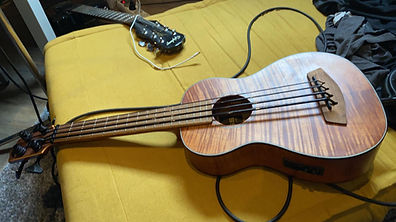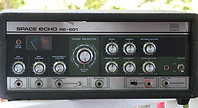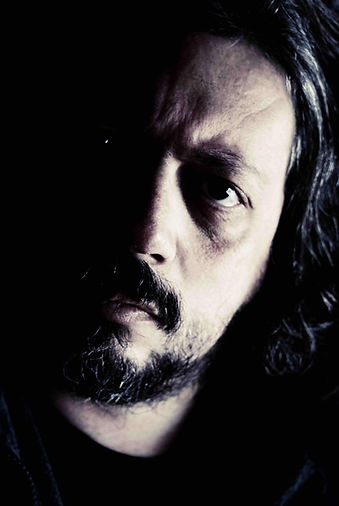



The debut album by TRT is set for a September 2021 release. It's a traditional LP length (40 minutes) and features 3 songs, one of which is over 17 minutes long. The CD features 2 separate mixes of the whole album, firstly an "Original Mix" (very 1970s inspired) and then a "2010 remix" in the style of a contemporary mix of an older album.
Much more detail follows, but in a nutshell, this album is inspired by a band seen playing in Italy in 1976. TRT have written and recorded music inspired by that performance as a conceptual "what if?" album. It has been recorded using modern equipment, but using instruments and techniques that were prevalent 46 years ago.
The album is a rollercoaster ride of full-on 70s style Progressive Rock with no apologies for its deliberate retro nature. Multi sectioned suites, liberal jazz usage, wild counterpoint running lines, all hinting at and successfully evoking the golden age of Rock Progressivo Italiano.

“The feeling I get from the music is one of pure unfettered joy... Rock Progressivo Italiano vibe brought right up to date for our modern times but music to give you some relief from the complexity of modern life...Simple but perfectly formed and harking back to the days when music just put a smile on your face” Martin Hutchinson. PROGRADAR.ORG

The album "Allium: Una Storia" is a concept album about a band who really existed in the 1970s, a band I saw play at a holiday camp in Italy. This band, to my knowledge, never produced a record, and if they did I have never found it. I have often wondered what happened to them, they were the first band I ever saw and they made a very big impression on me that has led me down a very long path of a musical career. in 2021, I asked my friends Antonio, Jonas and Roberto to help me create an album, inspired by this band, and to make the album I imagine they would have made in 1976.
PART ONE: How I Met the band "Allium" (This story is included as part of the album sleeve.)
In 1976 my parents took me on a European Holiday. And although we visited many of the countries there, the jewel in the crown of the trip (for my parents) was a week in Italy where they wished to see the great Basilicas of Rome & Florence. For me, a steam hauled railway line in Austria was my focus at the time. But in the end, it was what happened in Italy that was actually important to me.

Me.. Andy Tillison in 1976-ish
We were staying on a large municipal camping site outside Rome. My parents were exceedingly disgruntled that our tent was pitched close to an entertainment venue where a band were playing each evening. I, on the other hand, was delighted. The band were extremely audible and the evenings at the campsite were full of what sounded like more than capable versions of quite sophisticated hit records from artists like ELO, Supertramp, Queen, Elton John and 10cc. I took to hanging around outside the door... I was too young to go in unaccompanied.
One day we had a "day at the campsite" rather than a trek around the city. My parents were further annoyed by the fact that the band struck up during the afternoon as well. However, I immediately knew that this music was not the same. I was hearing music I didn't know, music that had time changes, ethereal passages, and of course I knew I was hearing Prog Rock. The preceding day I'd bought a copy of "Per Un Amico" by PFM on pre-recorded cassette. I wandered over to the building again making some lame excuse to my folks that I was going for a walk.

My mother and me in Rome the day after the meeting
Nobody stopped me walking into the building, (I presume because there were no bars open at this time), and the concert hall doors were glass so I stared through to watch what was happening. I had a perfect view of the stage. I was watching the first rock band I had ever seen. Glued to the spot, nailed to the floor, I felt my breath quickening by the minute. After 20 minutes of watching this (rehearsal of course) the singer jumped off the stage, came through the door I was staring through in order to take advantage of the toilets in the foyer. On his return journey he just said... "English?" I nodded rather shyly. His rich Italian accent said, "You like our music yes?" He beckoned me to come inside the hall and offered me a seat, at an empty table in an empty hall.
The singer walked back onto the stage. Well. He jumped up as I would learn to do for the next 20 years. They had a drummer, a bassist, a guitarist, a guy who played violin and wind instruments, flute and sax, the singer and of course....

My own (sadly sold on) Minimoog
A Keyboards player. By 1976 I was 16. And I had enough records now to know what a Minimoog was, and to know that I was looking at one. Sitting atop a Fender Rhodes Suitcase facing the audience, at right angles to a Crumar Organ with a Solina string machine on top of that. Until today, these instruments were friends I had seen on record covers and in music mags from NME to "Beat & Instrumental". Today, I was meeting those friends in person for the first time.
It got better....
I loved their performance, they played a very long piece (which is represented on the "Allium" album) and then they took a break. And they came and sat around my table. The singer, who was called Roberto asked me if I'd enjoyed that to which of course I was nodding vigorously. I still hadn't dared speak. He laughed and said "my friends will not understand you they are fom Albania"
I felt very priveliged of course to be speaking to people who I naturally assumed were "stars", and they must have been at LEAST three years older than me and had far cooler haircuts. I've often wondered if a Brit band would have been so welcoming. I fished in my pocket and pulled out "Per Un Amico". It was as if I'd shown a "Royal VIP Pass" at Ascot Races.
Next thing I knew I was on the stage looking at the instruments.. seeing my first real pro guitars, drums - becoming aware for the first time of the onstage paraphernalia of cables, monitors, setlists and pedals.. a place that although never fixed in location would be a second home to me for many years. I couldn't keep my eyes off the keys etc. And without any prompting Roberto just said the magic words....
"You play?"
After a brief conversation with Roberto in Italian, the keyboards player motioned me and suddenly I was standing there. I was seeing what Rick Wakeman saw. I was seeing that glorious control panel that I still have so many variants of to this day. The Minimoog Model D. The player kicked out an amazing line on it and then did a hand motion that said "go ahead".
I need to say that at this age I was no great shakes on the keys, but knew enough to realise that the sound was close enough to do what I did next. I gulped and played the opening synth riff from "E Festa" (Celebration) by PFM. I even got it right. I was gonna stop out of shyness, but the drummer just joined in and in seconds I was actually playing with a band. It probably sounded awful, and hey, it was only the riff, I didn't know what to do next or anything, aso it was basically just what I'd later come to know as a Jam.
But it was enough.
They had a tape of their "not finished" album. They let me have a cassette copy along with a card mockup of their album cover from their merch desk and the cassette became the soundtrack for not only the rest of the holiday, but quite a lot of the following two years. The album (which simply said "Allium" in biro on the cassette label) became a heavy rotation album for me. When I personally think back to those times I think of this album within the same parameters as "Godbluff", "Snowgoose", "Ladies & Gentlemen" and "Trick Of The Tail".
Although the two worlds seem so far apart now, by the time my student flat was burgled while I was at a Punk gig in Wolverhampton, only two years had passed.. if that. I lost the Allium tape for one reason only. It was the one that was in the tape deck. As it often was. Yeah, I used to brag about this band I'd met, how I'd played with them blah blah blah. It WAS a great album though. I never, ever heard it again.

PART TWO: After the event...
In 2021 during the coronavirus lockdowns I took the opportunity to try and somehow commemorate the totally unknown band who had started me down the long and complex road of a musical career. The concept of this album was simply to make a new recording inspired by the music I heard that day, and my memories of the tape that I possessed for a couple of years more than 40 years ago.
The songs contained on this record are new original compositions by TRT - made as impressions of the music the band played. Although I designed the basis for each song Jonas and Roberto were writing parts for each composition and Antonio De Sarno contributed a set of lyrics that reflect the isolation that the Albanians might have felt, exiled in Italy in order to play the music they loved.
I do not know what happened to them, who they were, or whether they ever did anything else. All I know is that they changed me. And this is a personal thankyou note to a band whose day never came.
PART THREE: How TRT made this album
This album was recorded using 2021 recording technology, backdated and restricted to offer us a palette and system compatible with what a band in 1970s Italy might have had access to.
We applied long forgotten “bouncing” techniques to enable us to use more instruments and made the final mixes from 16 tracks, representing a high quality studio in 1976. Bouncing is the procedure where one records say 6 keyboards instruments onto six tracks and then those six tracks are mixed down onto just two tracks, freeing four tracks back up again. This was part and parcel of recording right through to the last years of the 20th century.
Wherever possible we used old instruments, notably bass guitar, Hammond, 6 string guitars, drums and Minimoog. These were augmented by digital simulations of period instruments. We did NOT use Polyphonic synthesisers like the Prophet 5, Polymoog or Yamaha CS80 as they did not yet exist in 1976.

Me and my Hammond which I saved from an abandoned building in 1994
We knew that the band owned a String Synthesiser, a Fender Rhodes piano, a Crumar organ and a Minimoog Model D (see above in Part 1). We assumed that the Studio they would have worked in would have other instruments available for them to use and so we let the "keyboards player" use a Hammond Organ instead of the Crumar. (In reality it was my own Hammond T1 and Leslie speaker built in the late 1960s). We also allowed the use of a Mellotron for Choral and Brass sounds, but for strings we used a Solina String Synth. (These were all highly accurate digital representations of the original instruments) We also assumed there would have been access to a traditional piano, and we chose to use an Upright piano as (from my own memories) when a studio in the 70s had a grand piano they didn't let the rock bands use it!
We actually chose the studio we were going to emulate, this being Phonogram in Milan, which was the first 16 track in Italy. It was used by many artists at the time, including some from the Rock Progressivo Italiano scene like Le Orme. All the digital reverb and echo machines used are models of plates, springs and tape driven analogue effects.
We switched off many of the functions we now have available. No auto tuners, no timing correctors and we all just played in time with a metronome. We decided after much thought to remove various gimmick ideas like tape hiss and vinyl surface noise, as we feel that the band Allium would have worked like dogs to get rid of anything like that.
We started the process by using digital drums, played by hand on a piano keyboard. This helped us get the basis for the next phase which was to record real drums for the album. I played the drums here at my own studio in Yorkshire England and although I have been able to play drums for 35 years and more, this was the first time I have taken on the role of "stick" drummer for an album . I made many many mistakes, and just played each section time and time again until we had something we could use.
We looked at how the bass and guitar sounded in Italian Progressive bands of the era and decided to go for a vintage "a little fuzzy" guitar sounds. Jonas recorded all the guitars at his studio in Austria. When it came to bass, we decided to go with something very different from what we would use on Tangent/Karmakanic recordings. We decided to try something like a Hofner "Violin" bass (think Paul McCartney in the Beatles). We found the sound we wanted in a very old semi acoustic bass, which actually looks more like a large Ukelele than a bass!. It had flatwound phosphor bronze strings coated with black vinyl!

The bass (and Epiphone 6 string) that Jonas used for the whole album
For wind instruments we used a combination of real saxes (played by Ray Aichinger) and very up to date and startlingly real sounding digital models. We used a lot of analogue style processing like Wah Wah, echo, reverb and distortion on these in the style of David Jackson of Van Der Graaf, (also from the first Tangent album). The original band themselves used these effects on the day I saw them and on the tape I once had of them.
For anyone who is horrified by the idea of an artificial representation of a flute, please remember that by the time I met Allium in 1976, the Beatles "Strawberry Fields Forever" was already 9 years old. Fake flutes and all the rest.
For Roberto's vocals which he recorded at home in Italy, we used a variety of simulations of a "Great British Spring" drainpipe reverberation unit and a Roland Space Echo (a tape based system which was hot tech back in 1976). We also used a model of a room of similar size to the main studio area at Phonogram Milan.


A Roland Space Echo and a Great British Spring Reverb
Every channel we recorded added a certain amount of simulated tape hiss, which we subsequently removed using a tape hiss removal simulator.... if that sounds mad, it was! Each track used a simulation of an anlogue recording mixer channel complete with transistorised preamplifiers, parametric equalisers and effects sends.
Immersion into a project like this is like a form of "method acting". During the recording I would send the members of the band graphic mock ups of the stages we were at. One inch tape spools, test pressings, album artwork, track sheets. When Roberto sent the vocals to us and the centre of operations moved from Italy to Austria, we priced up how much it would cost to send the four one inch tapes from Milan to Vienna. It came to more than 100 Eur and took 2 days.
We had Albanian or Italian names for each other, I was Afrim Tanush, Jonas was Janusz Rhexpi and Roberto retained his own first name and took Antonio's last name becoming Roberto De Sarno. These little touches seemed to help by making the process quite fun and removing us from the tightly controlled lockdown procedures that had kept us housebound for so long, allowing us to travel in time and space in our imagination. We spent a lot of 2021 living in 1976.

Antonio De Sarno wrote all the lyrics for the album, and he wrote them as if from the point of view of Albanian illegal immigrants into Italy at the time. Italy was a politically diverse place at the time with a very wide gulf between the Fascists and the Socialists. Italy had a much less regulated media industry than the UK and like now on the internet, there would have been radio and TV channels from both sides and all points between the two extremes.
Essentially, we wanted to work using the same workflows as our ancestors Allium, and we wanted to find and overcome the same problems they did. On top of that we did it in three different countries in the middle of a Pandemic.
This is, however, a homage. Not a forgery. Anyone with knowledge of recording techniques could tell this is not a 1976 recording. What we wanted to do is create a flavour and an atmosphere in which we could make the closest production to what this band would have been able to do at the time. This album was 100 percent sonically possible in 1976.
It was made with computers and Love. That's all we needed.




